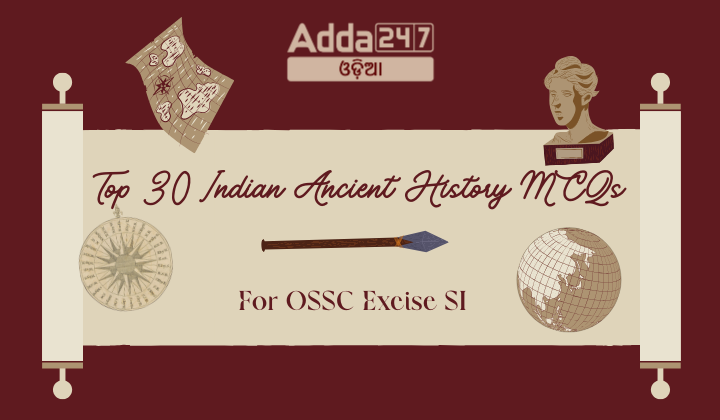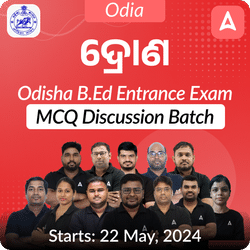Preparing for the OSSC Excise SI exam requires a good understanding of Indian ancient history. Here are the top 30 Indian Ancient History MCQs that will help you in your preparation. These questions cover important topics such as the Indus Valley Civilization, Vedic period, Maurya and Gupta empires, and significant historical figures and events. Focus on key areas like the contributions of Ashoka, the significance of the Rigveda, and the achievements of ancient Indian scholars. Practicing these MCQs will enhance your knowledge and boost your confidence for the exam.
Top 30 Indian Ancient History MCQs For OSSC Excise SI
- When was the Indus Valley Civilization established?
a) 5000 BC
b) 4000 BC
c) 3300 BC
d) 2600 BC
Answer: c) 3300 BC - Which site of the Indus Valley Civilization is known for being the first to show evidence of cotton cultivation?
a) Harappa
b) Mohenjodaro
c) Kalibangan
d) Mehrgarh
Answer: d) Mehrgarh - Which of the following cities was discovered first during the excavation campaigns of 1921-22?
a) Lothal
b) Dholavira
c) Harappa
d) Mohenjodaro
Answer: c) Harappa - Who among the following conducted the first excavations at Mohenjodaro?
a) John Marshall
b) R.D. Banerjee
c) Mortimer Wheeler
d) Daya Ram Sahni
Answer: b) R.D. Banerjee - Which of these was the main agricultural crop of the Indus Valley Civilization?
a) Maize
b) Rice
c) Wheat
d) Millets
Answer: c) Wheat - Which of the following was not known to the people of the Indus Valley Civilization?
a) Gold
b) Silver
c) Iron
d) Copper
Answer: c) Iron - The seal depicting a three-eyed figure, believed to be an early form of Lord Shiva, is known as:
a) Dancing Girl Seal
b) Priest-King Seal
c) Pashupati Seal
d) Faience Seal
Answer: c) Pashupati Seal - Which of the following was a major center of trade and known for having a dockyard?
a) Harappa
b) Mohenjodaro
c) Lothal
d) Kalibangan
Answer: c) Lothal - What was the primary method of disposal of the dead in the Indus Valley Civilization?
a) Cremation in urns
b) Burial in wooden coffins
c) Exposing to elements
d) Mummification
Answer: b) Burial in wooden coffins - What was the main reason suggested by Robert Raikes for the decline of the Indus Valley Civilization?
a) Aryan invasion
b) Tectonic movements and floods
c) Climate change
d) Foreign invasions
Answer: b) Tectonic movements and floods - Which of the following Vedas is considered the earliest form?
a) Samaveda
b) Yajurveda
c) Rigveda
d) Atharvaveda
Answer: c) Rigveda - Which Veda is known as the Veda of melodies and chants?
a) Rigveda
b) Samaveda
c) Yajurveda
d) Atharvaveda
Answer: b) Samaveda - What is the meaning of the term ‘Rigveda’?
a) Worship Knowledge
b) Melodious Chants
c) Magic and Charms
d) Praise Knowledge
Answer: d) Praise Knowledge - Which Veda is associated with ritual-offering mantras and is also called the book of prayers?
a) Rigveda
b) Samaveda
c) Yajurveda
d) Atharvaveda
Answer: c) Yajurveda - Which of the following Vedas contains the oldest known Vedic Sanskrit text?
a) Rigveda
b) Samaveda
c) Yajurveda
d) Atharvaveda
Answer: a) Rigveda - Which Veda is referred to as the ‘book of magic and charms’?
a) Rigveda
b) Samaveda
c) Yajurveda
d) Atharvaveda
Answer: d) Atharvaveda - The ninth book of Rigveda is solely dedicated to which of the following?
a) Agni
b) Indra
c) Soma
d) Varuna
Answer: c) Soma - Which of the following is NOT one of the meters used in Rigvedic hymns?
a) Gayatri
b) Anushtubh
c) Trishtubh
d) Mandala
Answer: d) Mandala - Which Upanishads are embedded in Samaveda?
a) Chandogya Upanishad and Kena Upanishad
b) Brihadaranyaka Upanishad and Isha Upanishad
c) Mundaka Upanishad and Mandukya Upanishad
d) Taittiriya Upanishad and Katha Upanishad
Answer: a) Chandogya Upanishad and Kena Upanishad - Which Veda contains hymns many of which were charms and magic spells?
a) Rigveda
b) Samaveda
c) Yajurveda
d) Atharvaveda
Answer: d) Atharvaveda - Who presided over the First Buddhist Council?
a) Ananda
b) Mahakassapa
c) Upali
d) Sabakami
Answer: b) Mahakassapa - Where was the Second Buddhist Council held?
a) Rajagriha
b) Vaishali
c) Pataliputra
d) Kundalvana
Answer: b) Vaishali - Under whose patronage was the Third Buddhist Council conducted?
a) King Ajatasatru
b) King Kalasoka
c) Emperor Ashoka
d) King Kanishka
Answer: c) Emperor Ashoka - Which Buddhist Council was held at Kundalvana in Kashmir?
a) First
b) Second
c) Third
d) Fourth
Answer: d) Fourth - Which Buddhist Council led to the division of Buddhism into Mahayana and Hinayana sects?
a) First
b) Second
c) Third
d) Fourth
Answer: d) Fourth - In which language were the deliberations of the Fourth Buddhist Council conducted?
a) Pali
b) Prakrit
c) Sanskrit
d) Magadhi
Answer: c) Sanskrit - What was the main objective of the Third Buddhist Council?
a) Preserve the Buddha’s teachings
b) Discuss ten disputed points under the Vinaypitaka
c) Purify Buddhism from opportunistic factions and corruption
d) Spread Buddhism to other countries
Answer: c) Purify Buddhism from opportunistic factions and corruption - Which of the following texts was composed during the First Buddhist Council?
a) Abhidhamma Pitaka
b) Vinaya Pitaka
c) Dhammapada
d) Milinda Panha
Answer: b) Vinaya Pitaka - Which council resulted in the compilation of the Abhidhamma Pitaka?
a) First Buddhist Council
b) Second Buddhist Council
c) Third Buddhist Council
d) Fourth Buddhist Council
Answer: c) Third Buddhist Council - Under whose patronage was the Fourth Buddhist Council conducted?
a) Emperor Ashoka
b) King Kanishka
c) King Ajatasatru
d) King Kalasoka
Answer: b) King Kanishka










